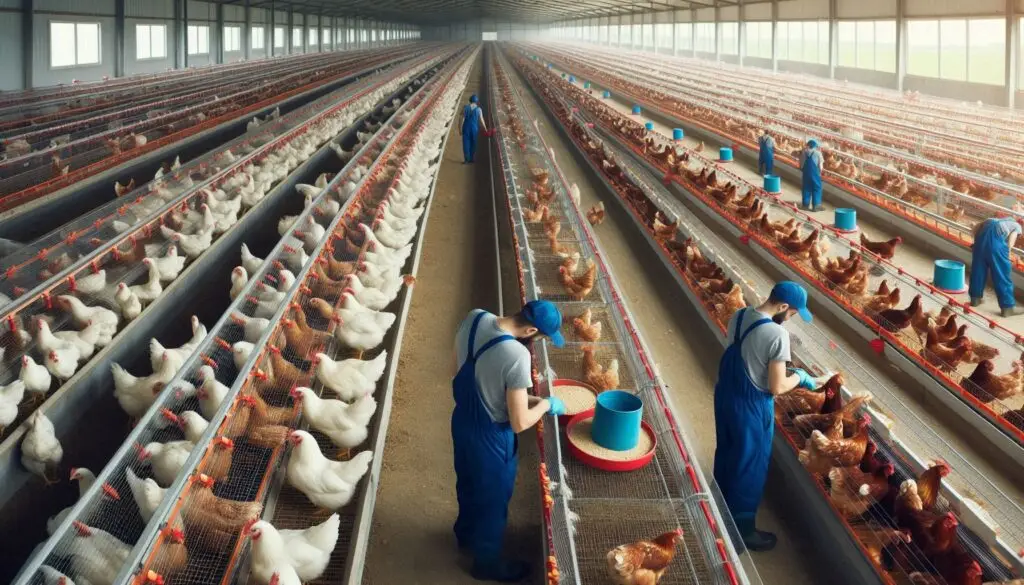The Ultimate Guide to Poultry Farming

Introduction to Poultry Farming
Poultry farming is a vital part of agriculture. It involves raising birds such as chickens, ducks, and turkeys for meat and eggs. This guide will help you understand the essentials of poultry farming, making it easier to start your own farm.
Benefits of Poultry Farming
Poultry farming offers numerous benefits:
Economic Opportunities
It requires less investment than other livestock. Farmers can see quick returns due to the rapid growth cycles of birds.
Nutritional Value
Poultry provides high-quality protein. Eggs and meat are essential parts of many diets around the world.
Sustainability
Waste can be used as fertilizer. This practice promotes sustainable farming methods and reduces waste.
Job Creation
It generates employment in various sectors. From farm workers to feed suppliers, poultry farming supports local economies.
Types of Poultry Farming Systems
Extensive Free-Range System
In this system, birds have access to outdoor spaces. This method allows them to forage and exercise. It promotes natural behaviors but requires more land. For more details on free-range systems, check out Waddle & Cluck’s Complete Guide.
Key Features of Free-Range Systems
- Natural foraging
- Improved bird welfare
- Higher quality meat and eggs
Intensive Confinement System
This system houses birds indoors in controlled environments. It simplifies feeding and disease control but raises animal welfare concerns. For insights on intensive systems, visit AgriFarming.
Key Features of Intensive Systems
- Controlled environment
- Efficient feed conversion
- Higher production rates
Semi-Intensive System
This approach combines elements of both free-range and confinement methods. Birds have some outdoor access while receiving supplemental feed indoors.
Key Features of Semi-Intensive Systems
- Balanced approach
- Moderate land requirements
- Flexibility in management
Choosing the Right Poultry Breed
Selecting the right breed is crucial for success. Here are some popular options:
Chickens
Great for both meat and eggs. They are versatile and widely accepted in various markets.
Ducks
More disease-resistant; require water access. Ducks can thrive in wet environments and offer unique meat products.
Turkeys
Lean meat but require more space. They are often raised for special occasions and holidays.
Consider factors like climate adaptability and market demand when choosing your breed.
Setting Up Your Poultry Farm
Site Selection and Housing
Choosing the right location is essential. Look for areas with good climate conditions and access to clean water. Housing should provide comfort with proper ventilation and space.
Key Features of Poultry Housing
- Ventilation: Essential for bird health.
- Space Requirements: At least 4 sq ft per layer chicken.
- Predator Proofing: Protects birds from wildlife.
For more information on housing options, refer to Britannica’s overview.
Feeding and Nutrition
Proper nutrition is vital. Develop a feeding plan based on age, breed, and weight. A nutritionist can help create an effective feed formula.
Daily Feeding Routine
- Provide age-specific feed daily.
- Ensure adequate feeder space.
- Supplement with scratch grains.
Health Management
Maintaining bird health is critical. Implement biosecurity measures to prevent diseases. Regularly monitor your flock for signs of illness.
Common Health Practices
- Vaccination against common diseases.
- Regular health check-ups.
- Maintaining clean housing conditions.
Record Keeping
Accurate record keeping helps in managing your farm effectively. Track data such as feed consumption and egg production to identify areas for improvement.
Marketing Your Poultry Products
Developing a marketing strategy is essential for selling your products effectively:
Sell Fresh Eggs
Market locally or wholesale through farmers’ markets or grocery stores.
Broiler Sales
Process or sell live birds at local markets or directly to consumers.
Value-added Products
Consider niche products like quail eggs or composting manure for additional revenue streams.
For effective marketing strategies, see Yoast’s guide.
Conclusion
Poultry farming can be a rewarding venture with proper planning and management. By understanding the various aspects outlined in this guide, you can establish a successful poultry farm that contributes to food security and economic growth.
More from Livestock Production and Management:
https://wiseias.com/opportunities-in-dairy-farming/






Responses